Learn how and why to balance your music across the frequency spectrum by analyzing what we at sonible usually call ‘Spectral Balance’.
In mixing and mastering music, the goals are often hard to define. Once we can take control over things like stereo width, loudness and EQ, how do we actually decide how far to go? One way we can say that a piece of music has been ‘produced well’ is in its tonal balance: the distribution of power across the entire range of the frequency spectrum.
Tonal balance (also known as spectral balance) is something we can evaluate to a very large degree with our ears, but if we want to understand why and how it works, we can take a closer look with our eyes. For this reason we use visual analysis tools like true:balance to get precise insights into how a track’s frequency spectrum is put together.
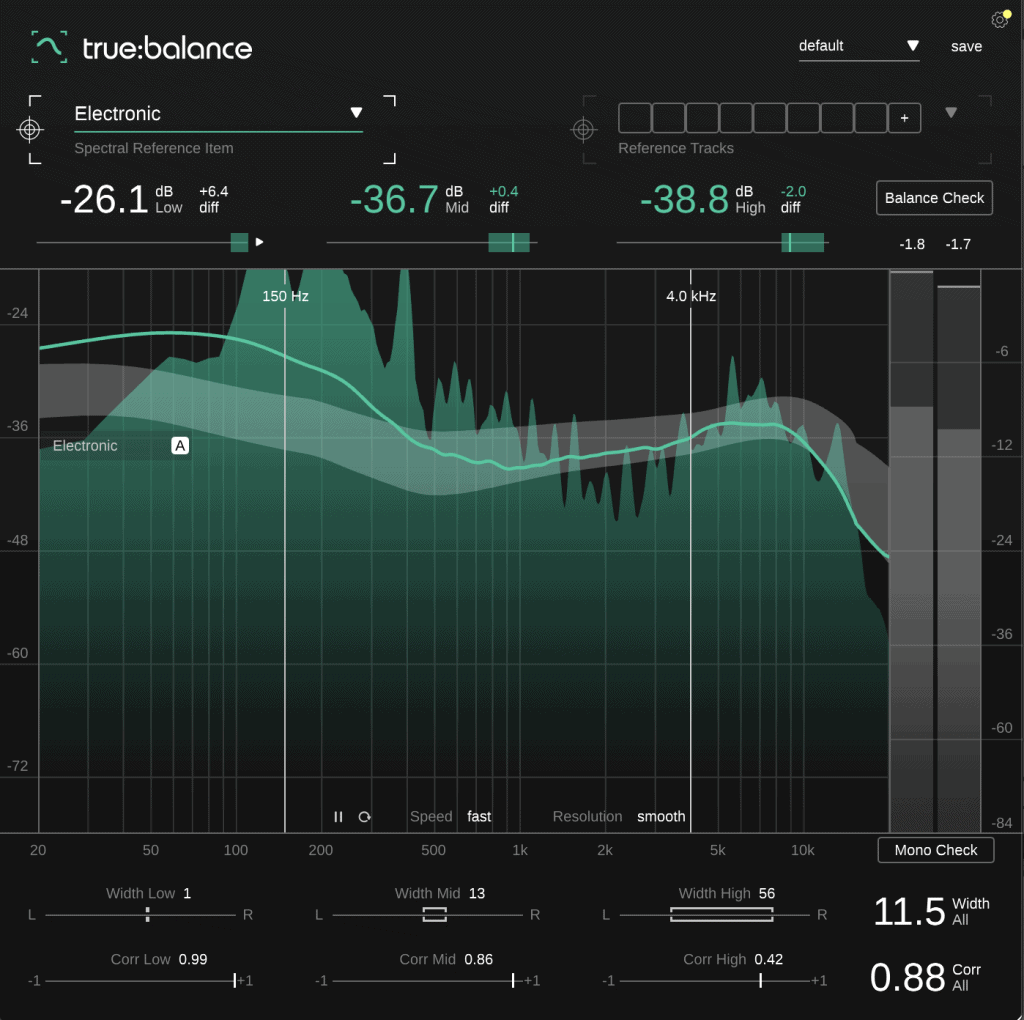
true:balance showing the profil “Electronic” against an input source
All sounds will occupy their own portion of the frequency spectrum, with a fundamental frequency providing the sound with its strongest audible pitch reference, and harmonics and overtones distinguishing its character elsewhere.
Because a track is made up of a mix of sounds layered on top of one another, all of the frequencies end up combining to create a particular sonic profile. Tonal balance, then, is simply the distribution of energy across the frequency spectrum that contributes to this profile. That distribution of energy defines the resulting character, or “tone” of a track.
Tonal balance is also referred to as “spectral balance”, a term which we prefer to use at sonible. Whichever term you use though, the most important thing is to get good tonal balance control in your mix and give it the best chance of performing at its best in any listening environment.
According to our own analysis of R&B, a ‘balanced’ or ‘typical’ profile starts strong in the bass, has a dip at roughly 400Hz then gradually rises towards the high end. We see a spike about 10kHz, and then a rapid die-off of very high frequencies.
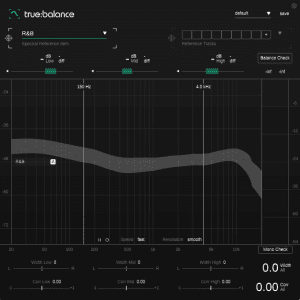
tonal balance of the genre profil ‘R&B’
Meanwhile, a typical classical music profile has level and sustained bass towards 400Hz, a gradual descent towards 3kHz, retaining clarity, and then dying off from that point on.
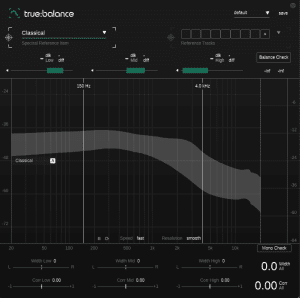
tonal balance of the genre profil ‘Classical’
When something is in balance, its component elements are properly or effectively arranged. Key to finding balance is accommodating proportion, and understanding how individual components relate to one another and the whole. Tonal balance in a mix requires energetic co-operation between competing frequencies and frequency ranges.
One simple analogy for this is that of white noise to pink noise. While white noise keeps each frequency at equal energy, and sounds harsh and ‘tinny’ to our hearing system, pink noise keeps each octave band at equal energy, sounding more balanced, although not necessarily nice. In a pink noise signal, level goes down as frequency goes up.
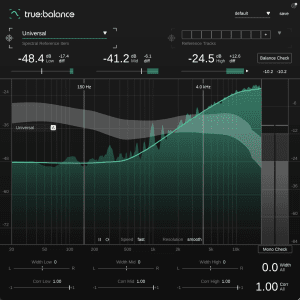
tonal balance of white noise
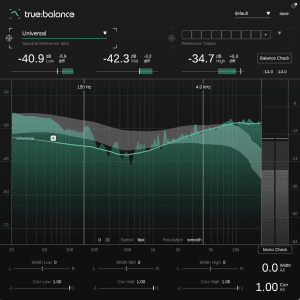
tonal balance of pink noise
It’s exactly this sort of profile we get in a piece of music that we say has a ‘good tonal balance’ – bass frequencies are the loudest, and the frequency spectrum calmly rolls off towards the high end.
When these proportions are skewed in some way, for example if the highs are too loud and the lows are lacking, then the listener will be forced to pick up the slack. In this case the anaemic low end would cause the track to feel weak, and the overpowered high end would cause ear fatigue.
As music producers we can’t be expected to have a perfectly calibrated apprehension of the tonal balance of a track, which is why metering tools like true:balance exist. The plugin’s Balance Check feature analyzes the current spectral (tonal) distribution of your signal then gives you text-based suggestions based on target reference curves to improve your mix.
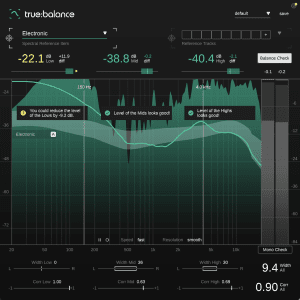
true:balance with suggested mix moves
It’s all well and good knowing that your track is tonally imbalanced, but what next? Well, the job now is to roll up your sleeves and redress the problems by making adjustments to the mix where necessary. This means making changes to the tonal and dynamic performance of instrument tracks so that they produce the desired overall sound.
One of the most obvious ways to do this is by EQing. Identify where the problematic energy in your mix is using either your ears or a visual analysis tool like true:balance, and then trim out offending frequencies that trigger unpleasant resonances or add any unwanted characteristics to the mix, as well as resolving any friction between elements competing in a frequency range.
You can treat instruments in isolation, however your primary concern shouldn’t be the tracks when they are soloed, but the combination of everything playing together. Think of this process as a kind of reverse engineering, where you work backwards to find and correct issues that are leading to a suboptimal tonal balance.
As well as making tonal balance adjustments via EQ, you can achieve similar results using other processing tools such as compression to frame the energy in a region of the frequency spectrum, or by simply turning things up or down.
Whether you’re someone who mixes as they go, or waits until every other possible task is done before getting started, understanding the tonal balance of your track is an essential part of getting a professional result. Tonal balance in mixing is about allowing each element the space to perform the role you’ve given it in the track, without stepping on the toes of anything else or unnecessarily dominating a frequency range.
For example, the kick drum and bass guitar are often jostling for space in the low end, so a common trick is to boost one frequency in one while subtracting the identical frequency in the other. Where exactly to make these cuts and boosts can be derived from the insights you get from a metering tool like true:balance.
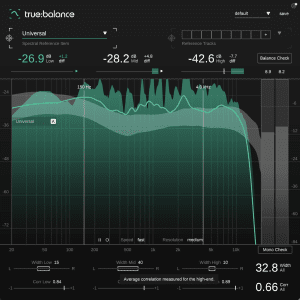
true:balance with harsh upper mids
All aspects of the track should be evaluated in the context of the overall mix, and all options considered. If there’s a build up of energy in the upper mids, you might need to hone in on the hi hats and tame them somewhat. EQ might not always be the answer, percussive bass sounds, for instance, can lose bass content if they’re compressed with the wrong attack time.
The goal of the mastering stage is to accentuate the good characteristics of the mix and rectify any deficiencies. A mastering engineer doesn’t have the luxury of being able to delve into the track stems, instead they will have to impact the tonal balance through precise moves with tools like EQ and compression on the stereo mix.
Since the “ideal” tonal distribution has a lot to do with the expectations of the listener, genre-based reference curves are great to compare your mix with. true:balance allows you to load up to eight reference tracks, as well as including built-in referencing options that have been produced through extensive researching of audio data and hands on mixing experience.
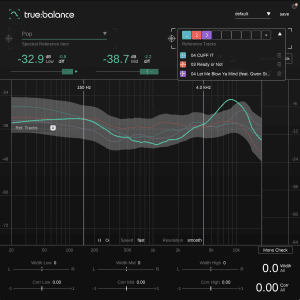
true:balance with reference tracks
When you load true:balance on the master channel and compare its tonal balance with a reference curve, the plugin delivers key readouts which are supported by target indicators. In this way you can easily see whether your track is close to the values of your chosen reference.
Tonal balance isn’t a static set of requirements for mastering, it will depend on the natural dynamics of the track, and also be guided by whether it belongs to an EP or album. A low end deficiency isn’t as detrimental in a verse than a chorus, for example, when the track should sound big and impactful.
Although visual analysis insights can be a powerful guiding force to help you find the elements and areas that may be affecting tonal balance, keep in mind that there is a necessary element of subjectivity and context. If there was one way of controlling tonal balance, everything would end up sounding the same, and that’s not what anyone wants.
Don’t get so caught up in reference tracks and target curves that you end up obscuring the natural sonic signature of your track. Your own taste will ultimately be what makes your music stand out from the crowd, so always be led by your ears and what sounds good to you.